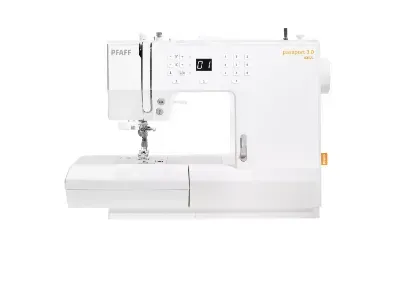Here’s a blog-style post about the PFAFF Passport 3.0 sewing machine, especially how it serves quilters and hobby sewers. If you like, I can write a version with NZ-pricing and availability too.
Meet the PFAFF Passport 3.0: Small Machine, Big Capabilities
The PFAFF Passport 3.0 is one of those machines that surprises you: compact and portable, yet packed with features that hobby sewers and quilters will love. Perfect for small spaces, sewing classes, retreats, or for anyone who wants serious functionality without a huge footprint.
Here’s what makes the Passport 3.0 stand out, and how those features translate into quilting and hobby-sewing advantages.
Key Features & Specs
Some of the key features you’ll find on the Passport 3.0 are:
Lightweight and Portable: About 14.7 lb (6.7 kg). (Quality Sewing & Vacuum)
100 Built-In Stitches, including utility, decorative, quilt stitches, satin stitches, buttonholes. (Singer)
Max stitch width of 7 mm. (Singer)
Integrated Dual Feed (IDT™ System): PFAFF’s signature feed system that feeds fabric from both top and bottom for even stitching. (Singer)
Thread Snips / Automatic Thread Cutter: Cuts both top and bobbin thread, trims tails. Handy. (Singer)
Free-motion capability: Drop the feed dogs from the back of the free arm; use the right presser foot. (Ken's Sewing Center)
Start/Stop button (to sew without a foot pedal), a speed slider, needle up/down, good LED lighting. (Singer)
How It Works for Quilting & Hobby Sewing
Here are some of the ways those specs matter in practice, especially for quilting.
Even Fabric Feeding = More Accurate Piecing
The IDT™ dual feed ensures that layers (e.g. quilt top pieces) move through smoothly and evenly. This reduces puckering, skewing, and mismatched seams—big plus when you want precise blocks and seams.Free-motion Quilting Made Possible
With drop-feed dogs and ability to accept free-motion presser feet, the Passport 3.0 lets you do stippling, free-motion quilting, or creative thread work. The workspace is smaller than a full-size long-arm or large machine, but for wall-hangings, baby quilts, or lap quilts it’s more than capable.Decorative and Quilt-friendly Stitches
The 100 stitch options include decorative and quilt stitches. For hobbyists who like adding embellishment (quilting stitches, satin, applique etc.), this gives a lot of flexibility without needing external attachments. Decorative stitching & wide 7 mm width helps highlight those details.Portability & Flexibility
Being light and compact means you can take it to quilting groups, retreats, classes, or travel with it. It’s also easier to store in smaller studios or sew-spaces. For many hobby sewers, this flexibility makes a big difference.Accessories Support
The machine supports a variety of presser feet (quilt / ¼-inch feet, free-motion, etc.), and has stitch plate markings, needle up/down, etc., which help when manoeuvring pieces, pivoting, quilting around corners. These little things add up.
Possible Limitations to Know
It’s not perfect for every situation. Some things to watch out for:
The throat space / sewing window is smaller than large-studio machines. If you plan to quilt large quilts entirely on the machine, you’ll want a big table or extension table. Handling big bulk under the arm can be awkward.
Free-motion quilting can be harder because of space. Heavy batting might be difficult to manage on a small model.
Some very thick layers (multiple batting, thick backs) may push the limits depending on needle & presser foot; you’ll need to use appropriate needles, adjust pressure, maybe slow speed.
Who It’s Best For
Beginners who want a well-featured machine without paying for huge industrial or large studio models.
Hobbyists who sew garments, home decor, plus occasional quilt projects.
People who go to sewing retreats or classes.
Quilters making smaller quilts (baby, lap, wall) or those who do piecing and then send larger quilting tasks elsewhere or do binding and quilting by hand.
Final Thoughts
The PFAFF Passport 3.0 strikes a strong balance between capability and portability. For quilters and hobby sewers, it offers:
Enough stitch variety and decorative choices to get creative.
Precise feed control (IDT) so piecing and quilt-top work can be more accurate.
Flexibility to try free-motion quilting without needing a huge machine.
If you value mobility, versatility, and a machine that can grow with your sewing (piecing, quilting, decorative work, and more), the Passport 3.0 is a solid choice.

